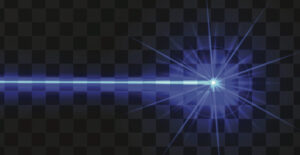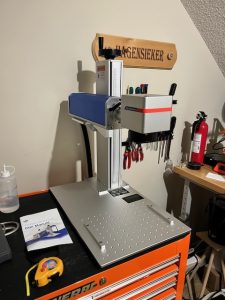Laser Buying Guide 2024

Laser Buying Guide
Welcome to my Laser Buying Guide for 2024. Selecting a laser engraver is harder than ever before. There are several types of lasers and more than a few selections within each category.
Over the years I have assembled many lasers and have sold more than a few. And I seem to get asked the same questions over and over by prospective buyers.
Most new, prospective laser purchasers probably find out too late what their new laser can and cannot do. It is important to understand the differences in laser types BEFORE you purchase one.
Types Of Laser Engravers
This blog is not all encompassing, but will discuss the common types of commercially available laser machines. Here are the types of lasers I’ll be discussing:
- Desktop Blue Diode Laser
- CO² Laser
- IR Laser
- Fiber Laser
Desktop Blue Diode Laser

Creality Falcon 2 Pro
This is the type of machine that most beginners start with. Additionally, desktop lasers are typically less expensive than other kinds of lasers. Blue laser diodes are usually around 5.5 watts and have a wavelength of around 450 nanometers.
Higher powered lasers beyond 5 watts are created by combing the beam of multiple diodes into one stream. Conversely, 2 diodes equals 10 watt output. 4 diodes equals 20 watt output.
These machines are best for engraving wood, glass, leather, paper, etc.
They are not very suitable for clear or light color acrylics or for marking metals. Many first time laser buyers are disappointed to find out that their new desktop laser cannot engrave on metals.
Desktop diode lasers move along the X and Y axis and have a manually adjustable Z axis to aid in focusing of the laser beam. A 2D machine that moves along the X and Y axis is referred to as a plotter.
The machine depicted in the photo is the Creality Falcon 2 Pro which I reviewed recently here.
Desktop diode lasers can range from just a couple of hundred dollars to nearly $2000.
CO² Lasers

OMTECH 50 Watt CO2 Laser
CO² lasers are generally more powerful than diode lasers and operate on a wavelength of 10,600 nanometers. This allows for cutting and engraving on various acrylics and plastics. It is even possible to cut and engrave on clear acrylics. Because of the higher power a CO² laser can perform engraving operations with relatively fast speeds.
CO² lasers are generally large and are contained within a cabinet which should be vented outdoors. Additionally, they are also identified by their long glass laser tubes which are water cooled. Also, this usually involves having a separate water chilling unit. The laser beam moves across a series of (usually) 3 mirrors. Alignment and adjustments can be overwhelming to a new user.
Conversely, the cost of a CO² laser is typically several thousand dollars.
The machine depicted in the photo above is the OMTech 50 Watt laser which I reviewed here.
IR Lasers

xTool F1 with 2 watt IR
I threw this in because more and more manufacturers are adding a low power, 2 watt Infrared (IR) laser to their machines in addition to a blue diode laser. IR lasers have a 1064 nanometer wavelength and can lightly etch metals and can also engrave acrylics.
Some manufacturers also sell IR laser modules for their desktop diode machines. I love the way black acrylic looks with an IR laser, however, using a low power IR laser can be frustratingly slow. Focusing must also be precise.
An IR laser is an inexpensive way to mark some metals and gives the laser operator some additional capabilities.
The machine depicted in the photo is an xTool F1 which I reviewed here
Fiber Lasers

Monport 30 watt fiber laser
Fiber lasers are best for engraving on metals. Much like an IR laser they operate at the same wavelength of 1064 nanometers but are typically much higher in power. This allows for deeper engraving operations. Because of the wavelength they are impractical for engraving on wood.
Setting up a fiber lasers is somewhat more complex than say a desktop diode laser and the user needs to input lens correction data into the laser engraving software.
Multiple lenses of different focal lengths can be utilized which allows for some additional Z height focusing operations.
The machine depicted in the photo is a Monport 30 watt Raycus fiber laser which I reviewed here.
Summary Of Types Of Lasers
Simply put, for best results, if you engrave wood you mostly want a desktop diode machine. If you intend to use clear acrylic you need a CO² laser. If you want to engrave deeply on metals you need a fiber laser.
Laser Buying Guide Recommendations
Desktop Diode Laser
- Creality Falcon 2 Pro ($1099 for 22 watt) – You simply will not find more useful features on a desktop diode laser than on this machine. It also has the highest Class of Safety rating obtainable. Highly recommended.
- xTool D1 Pro 2.0 ($899 for 20 watt) – xTool is a long time favorite of mine. xTool is innovative and has excellent support.
To sweeten the deal, the Creality Falcon 2 Pro has a 10% Discount Code: FNPALL10
Additionally there are other campaigns to make the deal even sweeter yet:
Subscription Gift: Subscribe to emails + Spend over $100 and receive a Plywood gift, valued at $25.99.
First Tier: Spend over $399 and receive 10pcs of Plywood, valued at $25.99 (Cannot be combined with the subscription gift).
Second Tier: Spend over $999 and receive a Falcon Material Discount Card, valued at $49.99
Third Tier: Spend over $1999 and receive a Rotary Kit Pro, valued at $189
CO² Laser
- OMTech 50 to 80 watt ($2199 – $2999, respectively). There are a lot of similar CO² lasers out there as many seem to be rebranded. I’m of the opinion that OMTech imports the machines and performs some upgrades and quality assurance actions before selling to the public. They also have an excellent Facebook Support Group.
- Without going to an industrial CO² laser I firmly stick with my only recommendation being OMTech.
IR Laser
There are really only two main players in the portable IR laser lineup. There are a couple other manufacturers who offer optional IR modules for desktop lasers but I’ll keep these recommendations for the dedicated IR machines.
- xTool F1 ($1599) The xTool F1 performs flawlessly and is a marvel of laser engineering.
- LaserPecker 4 ($1799) I did a shootout between the F1 and LP4 and really did not like the LaserPecker 4. Your mileage may vary.
Fiber Laser
Fiber lasers are also similar in that they seem to be sold and rebranded by at least a couple of sources. I personally own a Monport laser but that was provided to me at a discount to review. Had I paid full price for a fiber laser I would have went with the OMTech offerings for the reasons I mentioned above in the CO² section..
- OMTech Fiber Lasers (various wattages and prices)
- Monport Fiber Lasers (various wattages and prices)
Final Thoughts
Many desktop diode lasers are very similar. The real difference maker is after sales support in my opinion. Just because it is inexpensive or very expensive doesn’t mean it can’t break. If you can’t obtain parts after a warranty period you really didn’t get a deal.
Because there seems to be some factories cranking out CO² and fiber lasers which are rebranded and sold, it makes sense to buy the one with customer support even if it costs more.
Always do your homework and talk to other users. Join forums of potential manufacturers and see what the current customers are saying.
And without trying to be too negative I recommend staying away from Ortur lasers. They were once the innovators and were first to the game but things have gone terribly wrong over there with customer support.
Good luck in your quest for finding the perfect laser for you.
